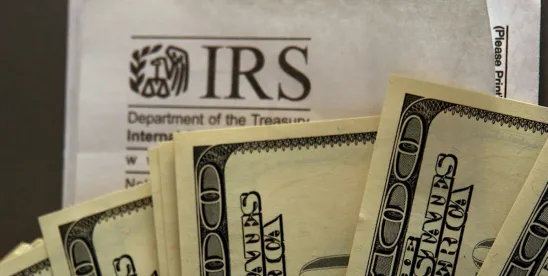On Aug. 15, 2024, the IRS announced a second voluntary disclosure agreement (VDA) program for companies that claimed the employee retention credit (ERC) enacted under the CARES Act. Companies that may have already received ERC refunds from improper claims should consider taking advantage of this VDA program before the IRS identifies the erroneous refund.
Background
This pandemic-era program provided a tax credit for wages paid between March 13, 2020, and Sept. 30, 2021, if (among other requirements) a company fully or partially suspended business operations due to a COVID-related government order or experienced a significant decline in gross receipts. The maximum credit allowed—assuming the company met numerous requirements —was $26,0000 per employee. However, many companies filed for the ERC even though they might not have been eligible for some or all of the credit. The IRS announced that the vast majority of pending ERC claims were improper and indicated it is likely many companies that have already received ERC refunds may have filed improper claims.
This resulted in the Aug. 15 announcement of a second VDA program, following an earlier program, which ended March 22, 2024. The IRS limited this VDA program to ERC claims for wages paid in 2021 (not for ERC refunds related to wages paid in 2020). Furthermore, it would not apply to any claim potentially considered criminal. In the case of fraudulent ERC claims, the company would need to utilize the IRS Criminal Investigation Voluntary Disclosure Practice.
Benefits of Entering This Second VDA Program
The new VDA program provides the following benefits:
- The company may keep 15% of the ERC refund it received, so 85% of the ERC must be repaid. (Note the 85% that must be returned is 85% of the total ERC, not the net amount received after paying a fee to a consulting firm or tax advisor who may have charged a percentage of the refund as a fee.)
- The company does not have to report as income the 15% it may retain.
- The company may keep any interest it received on the ERC refund (if the company repays the entire 85% of the refund as required).
- The company does not have to file an amended income tax return to reduce deductions by the amount of the ERC for the year it claimed the credit.
- The company may file another amended return to reinstate the deduction for wages paid if it has already filed an amended income tax return to reduce deductions by the amount of the ERC.
- The IRS will waive penalties.
Companies that participate in this program and amend their federal income tax returns for the year the ERC applied to reinstate the deduction for wages paid by the ERC amount may generate a refund. On the other hand, if a company has not yet amended its income tax return to reduce its deduction for wages by the ERC amount, there may be no additional income tax benefit to participating in this program.
Eligibility Requirements
Companies must satisfy the following requirements to be eligible to participate in this second VDA program:
- The company must not be under criminal investigation or notified that the IRS intends to commence a criminal investigation.
- The IRS must not have received information from a third party alerting the IRS to the company’s noncompliance (potentially from an ERC consulting firm, itself under examination by the IRS), nor received information regarding noncompliance from an enforcement action (once again, potentially an enforcement action against an ERC consulting firm).
- The company is not under an employment tax examination for the first, second, or third quarters of 2021 (the period to which the VDA program applies).
- The company has not received a notice from the IRS that it is recapturing (clawing back) the company’s ERC.
- The company has not received a demand for repayment of all or a portion of the ERC.
- The company provides information regarding the advisor or return preparer who assisted or advised the company in claiming the ERC.
- The company signs a closing agreement to document compliance with the VDA.
How to Enter the VDA Program
To enter this VDA program, the company must file Form 15434, “Application for Second Employee Retention Credit (ERC) Voluntary Disclosure Program,” by Nov. 22, 2024, signed under penalty of perjury, and:
- Include the company’s name, taxpayer ID, current address, and daytime phone number. If an attorney, accountant, or other practitioner will represent the company, a Form 2848, “Power of Attorney and Declaration of Representative” should be included.
- Identify the periods the company claimed the ERC and the amount claimed (remember, 2020 quarters are not eligible for this VDA program).
- Agree to extend the time for the IRS to assess employment tax by signing a Form SS-10.
- If a third-party payer (such as a PEO or payroll company) claimed the ERC on the company’s behalf, the company must include the pages of the Schedule R allocation schedule attached to the Form 941 that the third-party payer filed.
- Identify the return preparer or tax advisor who assisted the company in claiming the ERC.
- Pay the amount due under the VDA program electronically by using the Electronic Federal Tax Payment System, making a separate tax payment for each quarter.
- If the company is unable to pay the entire 85% of the ERC required under this program, include a completed Form 433-B, “Collection Information Statement for Businesses” and all supporting documentation. In addition, all potentially “responsible persons” responsible for the company’s payroll tax administration must submit their own Form 2750, “Waiver Extending Statutory Period for Assessment of Trust Fund Recovery Penalty” (see Second ERC-VDP eligibility questions: Question 3).
This last requirement to submit a Form 2750 marks the first time the IRS has expressly raised the implication that if there is a clawback of improper ERC refund claims, and the company is unable to pay the tax, the responsible persons would be held personally liable. This is surprising because the ERC is a credit against the employer’s portion of payroll taxes (Social Security or Medicare taxes, depending on the quarter), but responsible persons are potentially liable for trust fund taxes, which are the employee’s share of payroll taxes to be withheld by the employer—individual income tax and the employee’s share of Social Security and Medicare tax. The IRS does not address how the ERC credit, which is not a credit against trust fund taxes, can result in potential personal liability. Nonetheless, the IRS has put the specter of personal liability on the table. We will need to wait for further explanation from the IRS on this but companies considering this second ERC voluntary disclosure should consider the potential risk of personal liability when deciding whether to participate.
Conclusion
This is the second VDA program for erroneous employee retention credits. Although not quite as generous as the initial VDA program that expired in March 2024 (which allowed a participant to retain 20% of the ERC), it demonstrates the IRS’s desire to resolve as many improper ERC claims as quickly as possible before aggressively enforcing erroneous ERC claims to claw back the refunds and seek penalties and interest. If past IRS enforcement initiatives provide any hint to future IRS enforcement, companies who have received improper ERC refunds should not expect another opportunity to resolve improper ERC claims on terms better than this VDA program, which ends Nov. 22.
Companies that may have received improperly claimed ERC refunds should consider participating in this VDA program. In some situations, a company may have been entitled to claim the ERC for a particular quarter, but not for additional quarters. In such a situation, a company could limit its participation in the VDA program for the quarters for which it was not entitled. For example, assume a company partially suspended business operations due to a COVID-related governmental order in effect for the first quarter of 2021, but which expired March 31, 2021. If the company claimed the ERC for wages paid for the second and third quarters of 2021, it was not entitled to do so. On these facts, the company may choose to enter the VDA program only for the second and third quarter refunds. However, the company should first consult with a trusted tax advisor to determine if it meets the requirements to qualify for the ERC refund.



 />i
/>i
